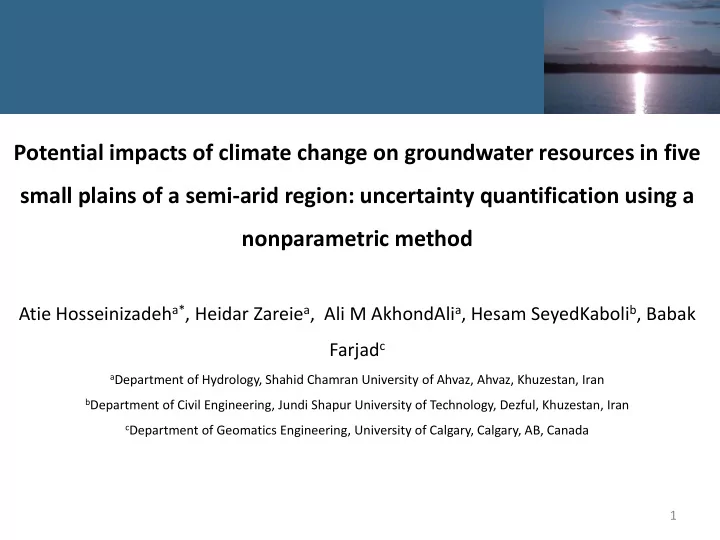

Potential impacts of climate change on groundwater resources in five small plains of a semi-arid region: uncertainty quantification using a nonparametric method Atie Hosseinizadeh a* , Heidar Zareie a , Ali M AkhondAli a , Hesam SeyedKaboli b , Babak Farjad c a Department of Hydrology, Shahid Chamran University of Ahvaz, Ahvaz, Khuzestan, Iran b Department of Civil Engineering, Jundi Shapur University of Technology, Dezful, Khuzestan, Iran c Department of Geomatics Engineering, University of Calgary, Calgary, AB, Canada 1
2
Climate Change: The greenhouse gases The trend of rising concentration is expected to rise global warming will during the present century by continue for decades global economic development. even if the present The impact of rising greenhouse greenhouse gasses gases concentration on climate concentration variables such as temperature decreases at the global and precipitation is inevitable. scale . Introduction Study area Method Results Conclusion 3
Climate Change: Introduction Study area Method Results Conclusion 4
Climate Change: Introduction Study area Method Results Conclusion 5
Groundwater: The numerical models are one of the best methods of assessing the quantity and quality of groundwater. These models are difficult and time consuming. However, in the recent decades research that uses simulation models have been developed due to the improvement of high-speed computers. The groundwater models actually are a simplified sample of reality. Introduction Study area Method Results Conclusion 6
Study area Introduction Method Results Conclusion
Methodology Framework: Groundwater Calibration Numerical Conceptual and model model Validation Projection Climate change recharge in future Rainfall in Downscaling GCMs future Method Introduction Study area Results Conclusion 8
Groundwater model Conceptual model : Method Introduction Study area Results Conclusion 9
Groundwater Model Numerical Model : Method Introduction Study area Results Conclusion 10
Groundwater Model Calibration : Method Introduction Study area Results Conclusion 11
Groundwater model Calibration : Method Introduction Study area Results Conclusion 12
Groundwater model Validation : Method Introduction Study area Results Conclusion 13
Climate Change: Number Model Emission scenarios Organizer Canadian Centre for Climate Modelling and Analysis (CCCma, Canada) 1 CGCM3T47 A1B, A2, B1 Center National Weather Research (CNRM, France) 2 CNRMCM3 A1B, A2, B1 Commonwealth Scientific and Industrial Research Organisation(CSIRO, Australia) 3 CSIROMk3.5 A1B, A2, B1 Max Planck Institute for Meteorology (Germany) 4 ECHAM5 A1B, A2, B1 Meteorological Institute of the University of Bonn (Germany) 5 ECHO-G A1B, A2, B1 Institute of Atmospheric Physics (IAP, China) 6 FGOALS-g1 A1B, B1 Geophysical Fluid Dynamics Laboratory(GFDL, USA) 7 GFDMCL2.1 A1B, A2, B1 Goddard Institute for Space Studies(GISS, USA) 8 GISS-ER A1B, A2, B1 Hadley Centre (United Kingdom) 9 HadCm3 A1B, A2, B1 Hadley Centre (United Kingdom) 10 HadGEM1 A1B, A2 Istituto Nazionale di Geofisica e Vulcanologia (NIGV, Italy) 11 INGV-SXG A1B, A2 Institute of Numerical Mathematics (INM, Russia) 12 INMCM3 A1B, A2, B1 National Institute for Environmental Studies (NIES, Japan) 13 MIROC3.2 A1B, A2, B1 Meteorological Research Institute, Japan Meteorological Agency 14 MRI CGCM2.3 A1B, A2, B1 National Center for Atmospheric Research (NCAR, USA) 15 NCARPCM A1B, A2, B1 Method Introduction Study area Results Conclusion 14
Climate Change: LARS-WG GCMs Rainfall and temperature in 2020-2044 Method Introduction Study area Results Conclusion 15
Uncertainty : This method estimates a PDF function for climate variables obtained from GCMs output, such as precipitation and temperature. In the non-parametric method, the density function (f) is unknown and should be determined using statistical analysis. The Kernel estimator with center K which is a symmetric density function such as Gaussian density. Method Introduction Study area Results Conclusion 16
Groundwater Balance : Results Introduction Study area Method Conclusion 17
Interactions of groundwater and surface water : Detail C Detail A Detail B Detail D Results Introduction Study area Method Conclusion 18
Climate Change Impact on Temperature : Results Introduction Study area Method Conclusion 19
Climate change impact on precipitation : Results Introduction Study area Method Conclusion 20
Climate change impact on groundwater : Results Introduction Study area Method Conclusion 21
Assessment of Uncertainty : Results Introduction Study area Method Conclusion 22
Conclusion : Results revealed that the largest increase in temperature occurs in May while the largest decline occurs in January and October. In other words, the rise in temperature is more pronounced in the wet season compared to the dry season. There is a shift in precipitation from fall to the late summer. The largest change in precipitation occurs in August. The pattern of change in recharge follows the precipitation pattern of change. There is a decrease in recharge in April, May, June, and October. The largest of change in recharge occurs by %40 in the late summer whereas the most pronounced changes occurs in the Lore plain. The largest uncertainty in simulation of recharge under GCM scenarios was determined in August, September, and December. The range of changes in recharge were determined between -%10 and +%13 in the Sabili plain, -%6 and +%10 in the Deymche plain, -%4 and +%10 in the western-Dez plain, and -%6 and +%26 in the eastern-Dez plain. The largest decline in groundwater level occurs in the Sabili plain in September. Conclusion Introduction Study area Method Results 23
Recommend
More recommend